I remember the first time I watched an English-dubbed Korean movie, well, that was a terrible experience. I couldn’t even finish the movie. After skipping dubbed films for quite a while last week, I watched a short film, and to my surprise, the dubbing was top-notch. But what was more surprising was that this was an AI-dubbed film. The dubbing industry has changed dramatically.
In this connected world, content has no borders, thanks to streaming platforms like Netflix, Amazon, etc. People all over the world watch great content with dubbing. But to be honest, dubbing is costly.
According to a 2022 report, studios spend approximately $100,000 to dub a 90-minute video in one language, and dedicate around 25% of their post-production time to do the dubbing. This high cost has limited creators from spreading their content worldwide until now. In this era of AI, you can’t even imagine how AI has rapidly transformed the dubbing industry.
In this article, I will explain the evolution of AI dubbing from conventional dubbing, examine how this tech works, and compare the different approaches available today. By the end of the article, you will learn what to consider when selecting a dubbing tool and what works best for you.
The Evolution of Dubbing: From Traditional Methods to AI
The history of dubbing dates back to the early 1930s. In 1929, the Spanish film Rio Rita was dubbed in Hollywood. Then, several other films came in, like the German film Der Blaue Engel (The Blue Angel), which was dubbed in English, French, and German in 1930. But unlike today, dubbing was a painstaking process back then.
What is Traditional Dubbing?
When we talk about traditional dubbing, it’s not only about translating the dialogue. It is the translation of emotion as well. A lot of work goes on behind the scenes. It’s a complex process from syncing the lip to the technical process. All that hard work to make the content accessible for the audience worldwide, overcoming the language barriers. Dubbing allowed people to enjoy foreign films and shows in their native language.
The Traditional Dubbing Process
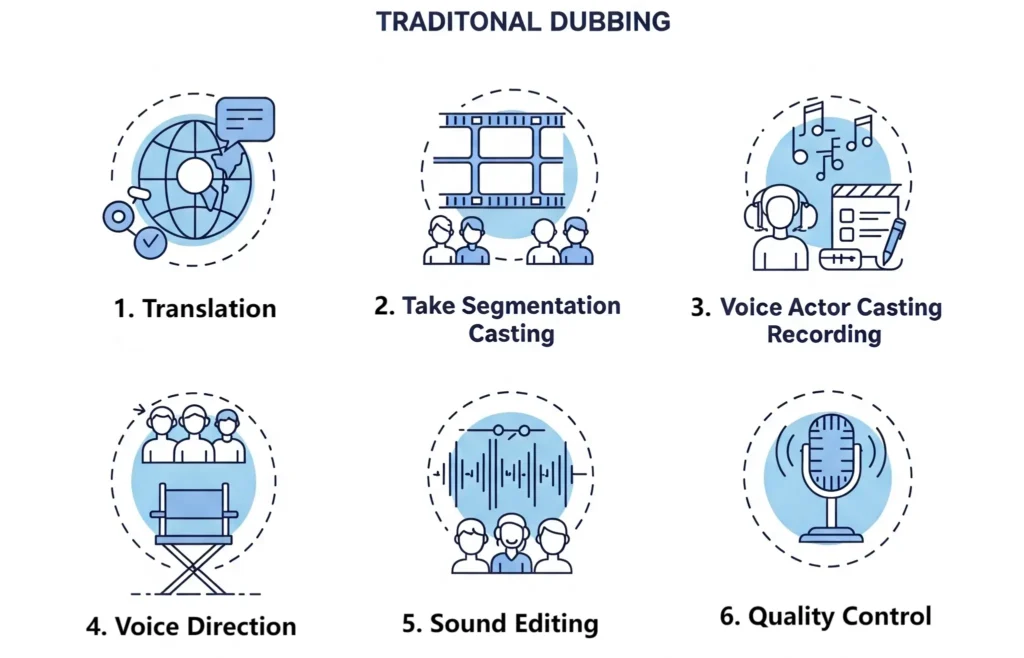
Like I mentioned, traditional dubbing is a complex process. It’s like multiple specialists working in concert to create a seamless final product. Let’s take a closer look:
1.Translation and Script Adaptation
The very first step with traditional dubbing is translating the dialogue from the original language to the target language. I once spoke with a script adapter who laughed about the misconception that this is straightforward translation work. In reality, you have to keep several things in mind while translating. Cultural nuances, slang, idiomatic expressions, humor, and cultural references are the few things that need more attention.
2.Take Segmentation and Dubbing Symbols
The translated script is then divided into “takes” or segments that the voice actor will record in a single session. A voice director once showed me these symbols, which include marks for pauses, overlapping dialogue, and emotional shifts, almost like a musical score for speech.
3.Voice Actor Casting
Then comes finding the right voice. Casting directors carefully select voice actors whose vocal qualities match the original performers’ style, energy, and characteristics.
4.Voice Direction and Recording
Voice is then recorded in specialized sound studios. Voice actors perform while watching the original footage, and a voice director guides the actors to ensure the same performance as in the original footage.
5.Sound Editing and Mixing
After the recording, sound engineers edit and mix the voices to make them seamless with the original. This involves syncing the lip, modifying pitch, balancing dialogues with background music, and ensuring consistent audio quality.
6.Quality Control and Final Check
This is the final step of traditional dubbing. Multiple reviewers review the content to check the consistency of synchronization, audio quality, or performance.
What is AI Dubbing?
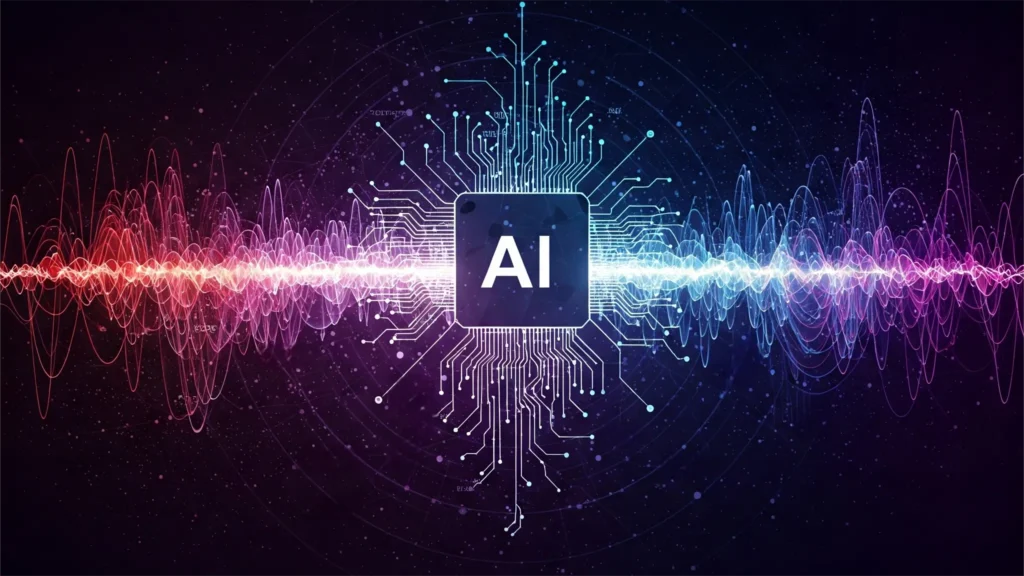
In its simplest form, AI dubbing is a technology in which we use Artificial Intelligence to translate dialogues from one language to another while maintaining the original speaker’s vocal character. AI dubbing automates many of the processes of traditional dubbing to minimize complexity, time, and resources. For example, it can automate translation, voice synthesis, and synchronization while keeping the actor’s vocal identity.
Core Technologies Behind AI Dubbing
The beginning of modern AI dubbing dates back to the 2010s with the first text-to-speech systems. But those were nothing like the human voice. Anyone could identify the robotic sound of early AI dubbing. Fast-forward to today, and we now have AI systems that are too close to perfect, thanks to deep learning neural networks. Companies like Synthesia developed algorithms for lip sync and voice cloning. By 2020, we had our first commercially available AI dubbing solutions. Over time, they just kept improving.
How Does AI Dubbing Work?
The AI dubbing process imitates the traditional dubbing process while removing the stress of doing everything manually.
Transcription: The process begins with transcription. AI speech recognition technology converts the audio file into text.
Translation: Then comes the translation part, where the generated transcript is translated from the original to the target language. Advanced neural machine translation (NMT) algorithms are used to do this.
Voice synthesis: In this step, the AI analyzes the original speaker’s voice, identifying vocal characteristics like pitch, tone, accent, rhythm, etc. Then, it recreates these characteristics in the new language.
Lip-sync alignment: This is the final process in which lip-sync alignment technology is used to adjust the timing of the synthesized speech to match the timing of the original voice. Some more advanced systems can subtly modify the visual elements to match the audio.
Advanced features in modern AI dubbing systems
Modern AI dubbing systems offer advanced features like voice cloning, emotional tone preservation, and automated lip-sync technologies. Voice cloning technology can now create a cloned profile of your voice from a 1-3 minute voice. Emotional tone preservation is another advanced technology where the AI detects and preserves the emotional markers (excitement, sadness, urgency, etc.) from the original audio. And the most impressive breakthrough is the lip-sync technology that uses neural networks to analyze and modify facial movements.
AI Dubbing vs. Traditional Dubbing: A Comprehensive Comparison
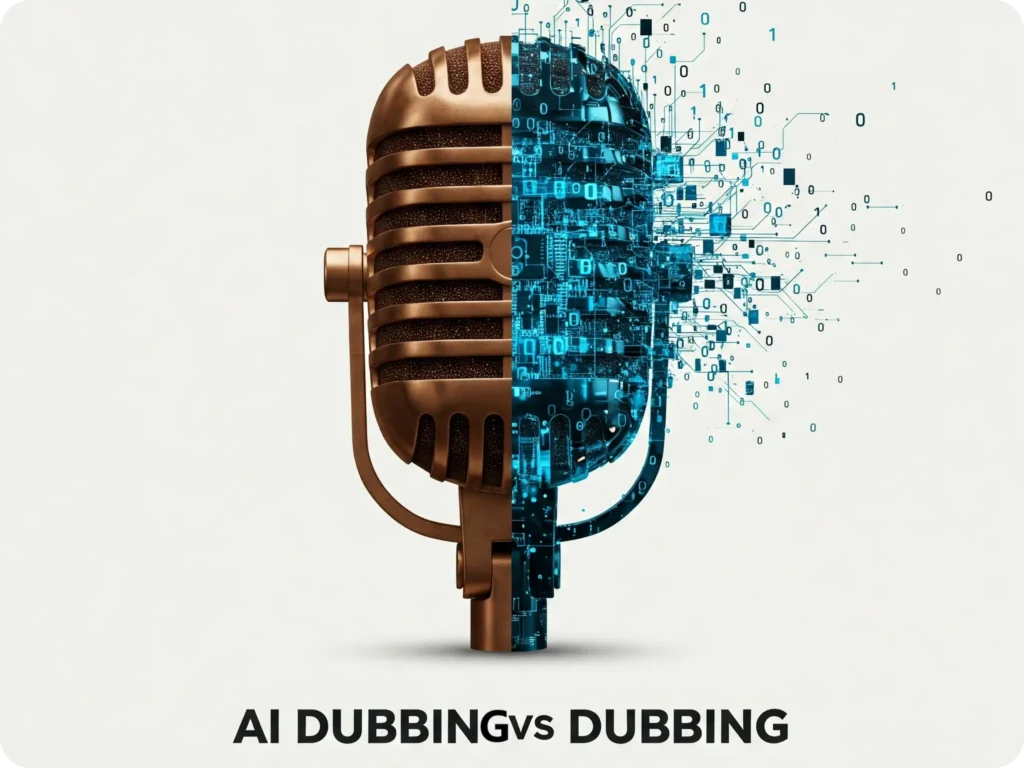
| Feature | AI Dubbing | Traditional Dubbing |
| Cost | More affordable; eliminates the need for voice actors, studio time, and engineering | High cost per language; expensive due to professional voice actors and sound engineers |
| Production Time | Minutes to days | Weeks to months |
| Voice Quality | Improving, but may sound neutral or robotic; limited emotional depth | Natural human voices with full emotional range and nuance |
| Emotional Range | Limited nuance in emotional delivery | Full emotional spectrum and subtlety |
| Scalability | Instantly scalable to dozens of languages | Each language requires dedicated production |
| Creative Control | Limited direction of performance | Complete creative direction is possible |
| Cultural Adaptation | May miss cultural nuances | Strong cultural adaptation through human translators |
| Lip-Sync Quality | Varies widely between platforms | Precise manual synchronization |
| Best For | Educational content, documentaries, corporate videos | Premium entertainment, dramatic content |
Both AI dubbing and Traditional dubbing have their pros and cons. While traditional dubbing is more precise in terms of emotional depth and accuracy, it’s costly and more resource-intensive. AI dubbing, on the other hand, is affordable and less resource-consuming. But it lacks the depth of emotional accuracy. Though some advanced AI dubbing tools allow for some alteration and tweaks that resemble the original voice. For example, AI can struggle to regenerate the sarcastic tone.
So, which one should you choose? To put it simply, if you have the time and budget to go through all the processes of traditional dubbing, feel free to do so for top-notch quality. But if you have a budget and time constraint, you can go for AI dubbing.
How to Choose the Right AI Dubbing Solution
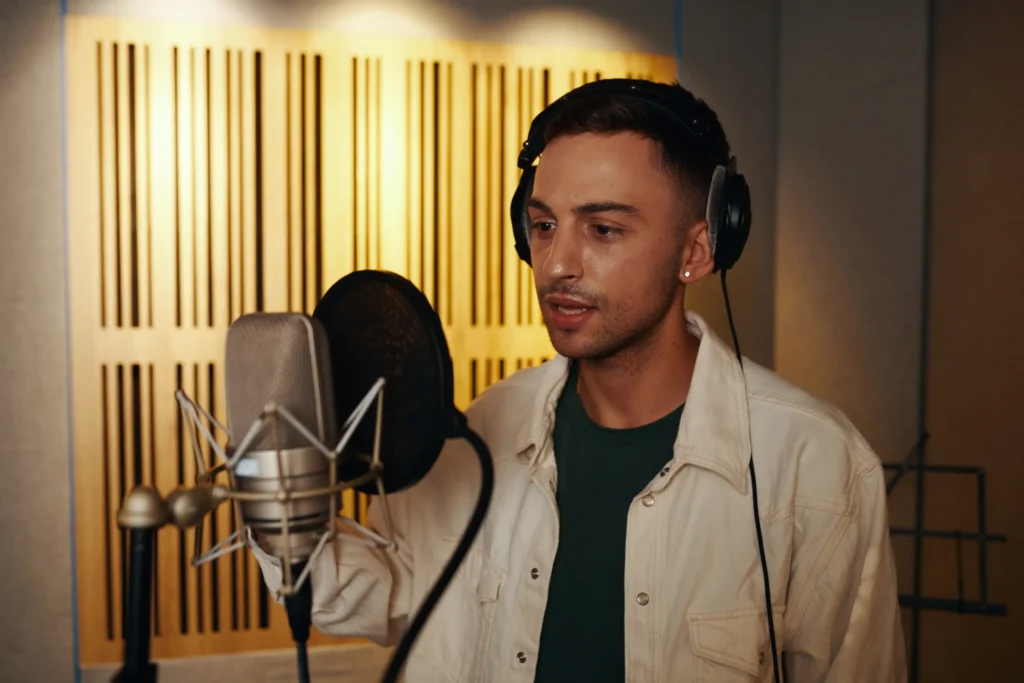
When it comes to choosing the right AI model, there are a few things we should consider:
Quality Considerations
First comes the quality. In 2025, you don’t want a voice that sounds like a robot. Voice quality should be the primary concern. Every AI tool offers a free test. Use it to compare different AI dubbing tools.
Technical Capabilities
Not all AI dubbing tools have the same capabilities. Look for the one that comes with comprehensive features. For example, tools that can handle translation, subtitles, dubbing, and editing in a single ecosystem. You should also consider advanced features like automated lip-sync adjustment, background noise preservation, etc.
Language support range
Many users make the mistake of counting the number of languages. They should count the quality. Many tools offer a range of languages to attract the user, only to find that one or two are quality. So, consider which languages you need and whether the tool can satisfy your needs.
User interface and ease of use
The user interface is an important part of any tool. If you don’t feel comfortable using the system, do not use it unless you have to.
Pricing models
Pricing is a major factor when choosing a dubbing tool. Like the language, do not just go for the cheapest tool. Sometimes, less costly tools offer fewer features and quality, too. Set a budget and choose the best one within that budget.
Security and privacy compliance
Double-check if your data will be stored privately or used to train the AI model. Many tools offer the option to turn it on and off. Make sure you have a clear understanding of it.
Vozo AI: A Leading AI Video Dubbing Solution
If you are looking for a dubbing solution that can help you with perfectly lip-synced, realistic dubbing, then Vozo AI could be the best option for you. Vozo AI offers a comprehensive ecosystem that handles everything from adding translated subtitles to dubbing videos in multiple languages. Vozo AI has a copyright technology, LipREAL™, which provides precise audio replication and emotions. What required days with traditional methods can now be done within minutes. Vozo AI also offers a VoiceREAL™ technology for custom voice cloning with precise audio replication and emotional nuance that maintains the original speaker’s personality.
Read More: Dubbing vs Subtitles: Which is Better for Video Translation
How to Dub Translated Videos with Vozo AI
Vozo AI comes with comprehensive tools that include AI-powered translation, voice cloning, and lip-syncing technologies. Let’s take a look at the step-by-step guide on how to use this tool with ease:
Step 1: Getting started
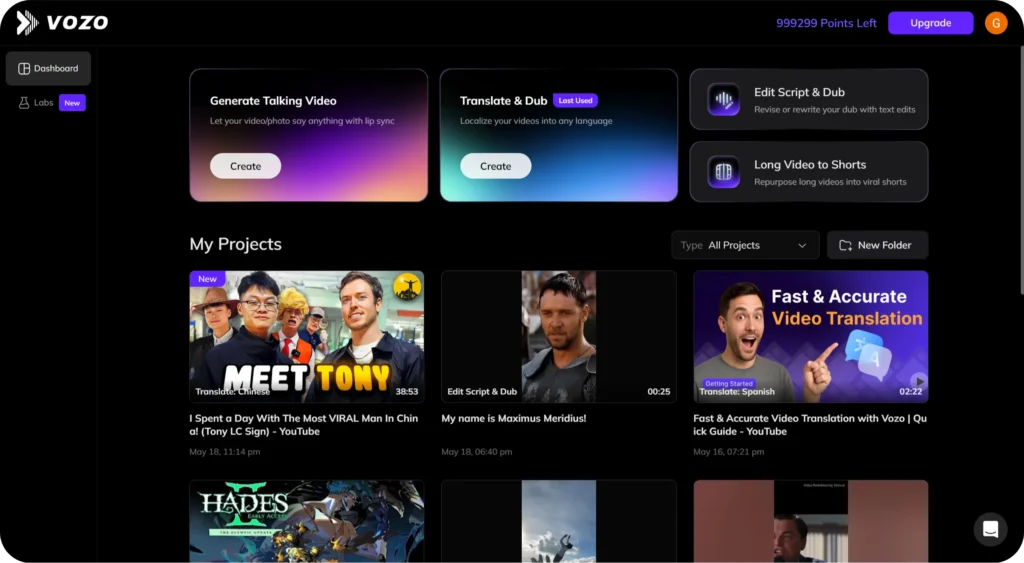
- First, you need to set up an account on the Vozo website. Just create the account or log in if you already have one. You will also get some free points to test Vozo.
- Navigate to the Dubbing Feature: Once the account is set, go to the dashboard, where you will find the options “Translate & Redub” or “Edit Script & Dub.” Choose the one you need.
- Upload the Video: You can simply drag and drop the video or paste the link of the video (YouTube, Google Drive, TikTok) to import it.
Step 2: Configure Your Dubbing Project
- Start by giving a name to your project. The system will give a name, but you can customize it as you want.
- Then select the current language of the video and the target language(s) you want to dub your video.
- If there are multiple speakers, the system will ‘Auto-Detect.’ But you can also do it manually.
- You can also make some optional settings like selecting the content genre, adding translated subtitles in the target language, etc.
Step 3: Starting the process
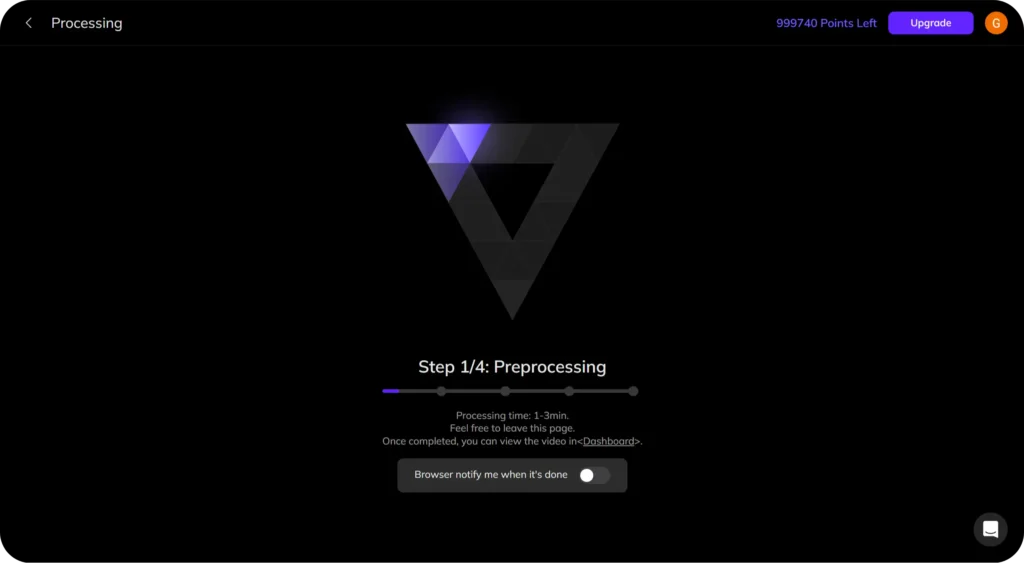
- After setting up everything, hit the “Start translation” button and let Vozo do its job. It will transcribe, translate, and then dub the audio in the target language.
Step 4: Customization

- After the initial processing, you will be taken to the editing interface where you can review the translation and dubbing.
- Here you can edit the script directly. Once the editing is done, hit the update button.
- You can also use the ‘AI Pilot’, which can help you proofread and refine translations. You can also use presets or give custom prompts to adjust the style and tone.
- Vozo also provides the option to adjust the audio. You can adjust the timing and speed by simply dragging.
- You can also choose or set certain emotions if needed.
- If the audio has multiple speakers, check if their respective dubbed voices are correctly assigned.
Step 5: Lip-Syncing (Optional)
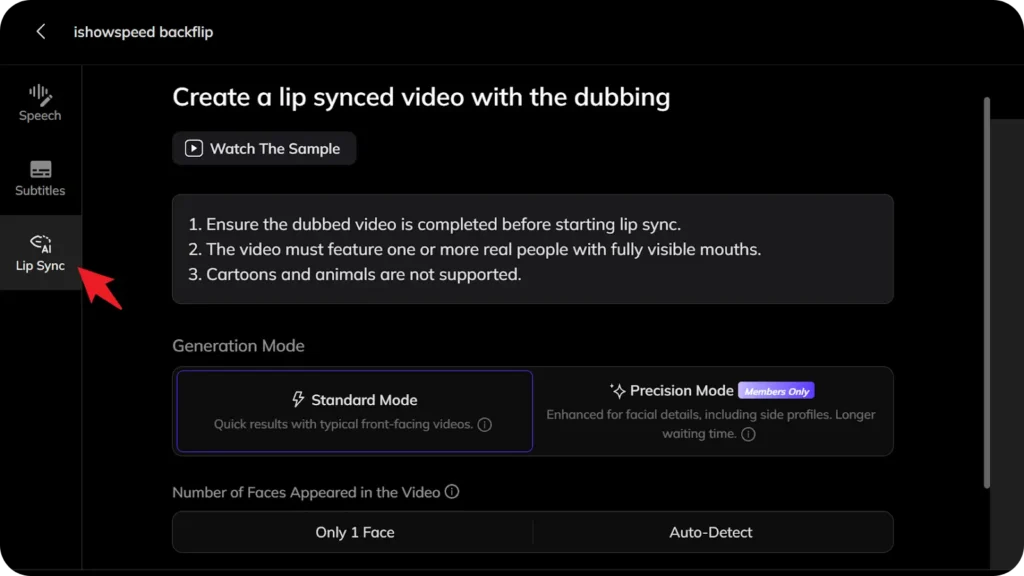
- In videos where the speaker is visible, use the Lip-Sync feature (Vozo LipREAL™) for a better result.
- Go to the ‘Lip-Sync’ option and start the process. You might need to specify the number of faces in the video to be synced. Vozo is smart enough to handle multiple speakers, even with head movements.
Step 6: Subtitle (Optional)
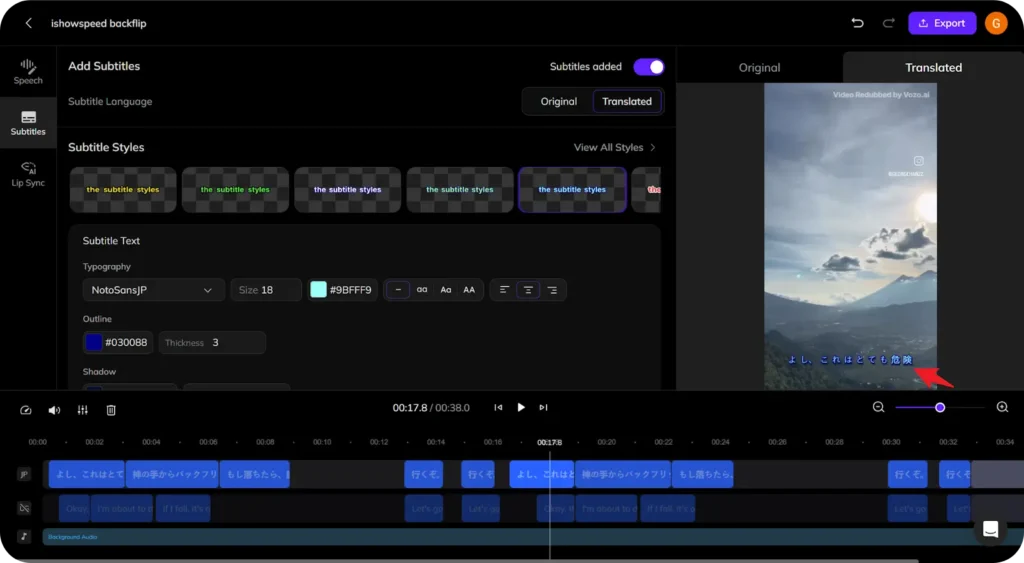
- In this stage, you can generate subtitles if you haven’t enabled the option before.
- You can also customize the subtitle. Choose from different templates or customize the font. Colot, animation, etc, to match your branding or style.
- Vozo also allows users to download the subtitles for both the original and translated languages.
Step 7: Finalize and Export
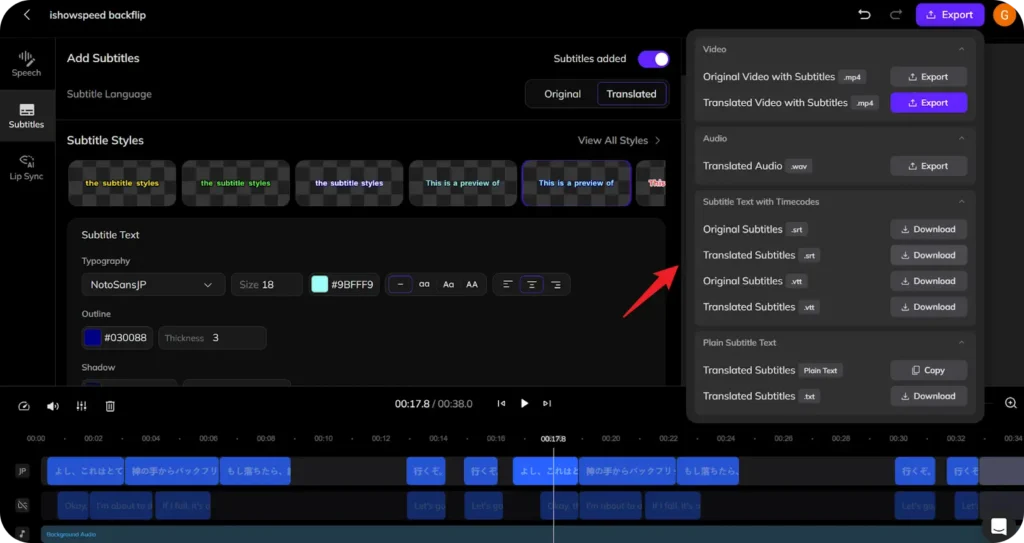
- Before exporting, preview the video. If you are satisfied, click the ‘Export’ button to export the video.
- Once the exporting process is completed, you will have the option to download the video.
Explore More Dubbing Tools:
Best AI Video Dubbing Software
How to Translate Youtube Videos to Any Languages
Conclusion
So what’s the final verdict? Well, of course, traditional dubbing, with its high cost and resource consumption, will have its place as a premium method, at least for now. But on the other hand, AI tools like Vozo AI are taking over the dubbing industry, and budget-conscious creators can now reach global audiences using AI dubbing tools.
Frequently Asked Questions (FAQs) about AI Dubbing
Q1: Is AI dubbing as good as traditional dubbing?
It depends on your needs. Traditional dubbing is best for emotional and dramatic content. But AI dubbing can give a satisfactory result for educational, informative, documentary, or corporate content.
Q2: Can AI dubbing handle multiple speakers in the same video?
Again, it depends on the tool you are using. AI dubbing tools like Vozo AI can handle multiple speakers in the same video.
Q3: Is AI dubbing suitable for all types of video content?
The straightforward answer is ‘No.’ If you have content that requires very complex emotions, AI dubbing tools can frustrate you. On the other hand, content with less emotional complexity (like informative, educational, or corporate) can have a better result with AI dubbing.
Q4: What key factors should I consider when choosing an AI dubbing solution?
Several factors, such as Quality, Technical capability, User interface, language support, Pricing, and privacy, should be considered when choosing an AI dubbing solution.
Q5: Do I need technical expertise to use AI dubbing services?
Not anymore. Dubbing solutions like Vozo AI have an interface that is easy to use even for newbies. For more, you can also check out the step-by-step guide for using the tool.



